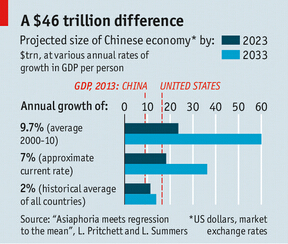出国网考研英语频道为大家提供2015考研英语题源阅读:China’s future growth,大家可以阅读一下!小编提醒大家要多阅读,考试阅读的速度才会快!
China’s future growth
A new study asks how long the Chinese economy can defy the odds
THE announcement this week that China’s economy had grown by 7.3% in the third quarter year-on-year was widely seen as marking the country’s “new normal” of slower growth. It was well below the roughly 10% pace China had averaged from 1980 until two years ago. Yet according to a new working paper by Lant Pritchett and Larry Summers of Harvard University, it is still abnormal: Chinese growth is likely to be lower still in future.

Forecasters often extrapolate from recent growth rates, the authors note. The IMF, for instance, projects that Chinese growth will slow almost imperceptibly over the next five years, from about 7.4% this year to 6.3% by the end of the decade. Yet Messrs Pritchett and Summers point out that if it is possible to infer anything from past patterns of growth around the world, it is that economies suffer from “regression to the mean”: growth rates in countries that have been growing fast tend to drop, often sharply, toward the long-run global average (of about 2% growth per year in real GDP per person).
Given this tendency, China’s long spell of breakneck growth—of more than 6% a year since 1977—already stands out. It is, the authors reckon, the longest such spell “quite possibly in the history of mankind, but certainly in the data”. In almost every other remotely comparable episode, very fast growth ended in a sharp slowdown, with a median drop in the growth rate of 4.7 percentage points. The IMF’s forecast of China’s growth over the next five years may seem slightly bearish, but it is wildly optimistic by historical standards.
China bulls may ask what it is that will hobble China’s growth, but the authors reckon the question should be reversed: the onus is on the bulls to explain why China should continue to defy history. Slowdowns often occur despite seemingly sound prospects: both Brazil in 1980 and Japan in 1991 looked like juggernauts, yet they managed scarcely any growth at all in real GDP per person over the following 20 years. A slowdown is not a sign of failure, they say; rather, persistent rapid growth suggests unusually good fortune or policy.
In China that has meant a broad move toward more liberal markets. The authors suggest that the way forward is treacherous, however. Richer countries are almost uniformly much more democratic than China. Yet a democratic transition (were China to embark on one) nearly always coincides with a period of falling growth (one notable exception being South Korea in the 1980s). For China to maintain its current rate of growth, in other words, it would have to beat long odds on multiple bets. The surest of historical rules of thumb implies that 20 years from now, China’s economy, measured by market exchange rates, will probably still be smaller than America’s (see chart).
温馨提示:如果你遇到生词和不懂的地方,可以点击翻译工具箱进行翻译!
推荐阅读:
| 考研英语大纲 | 考研英语词汇 | 英语作文万能句子 | 考研英语真题 | 考研英语作文 | 考研复试英语 |